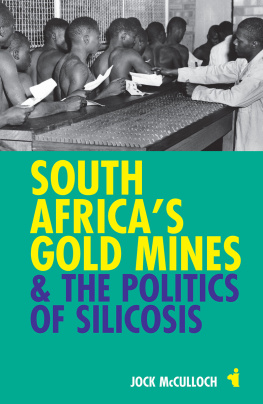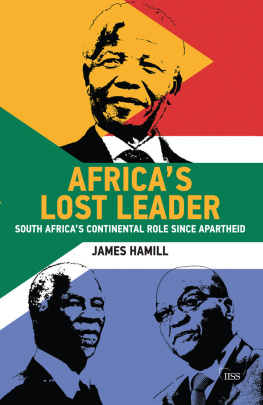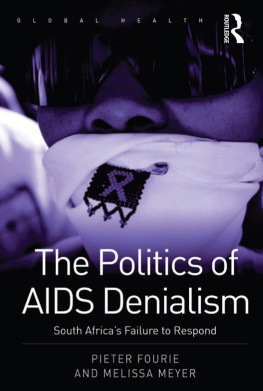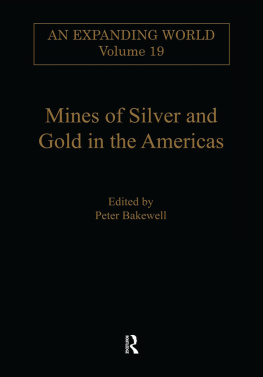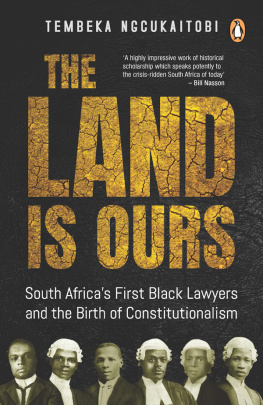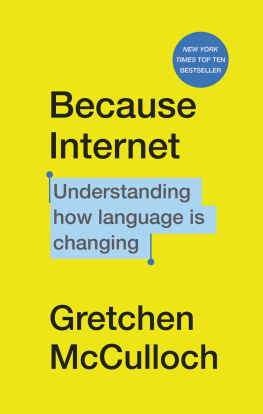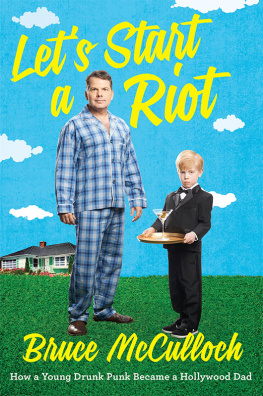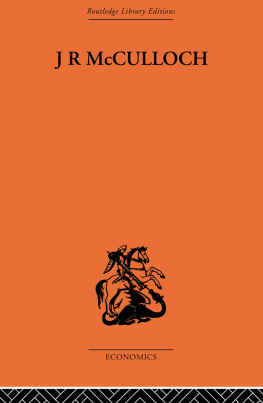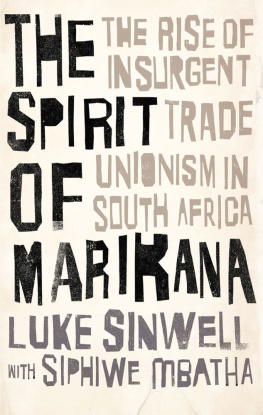AFRICAN ISSUES
South Africas Gold Mines & the Politics of Silicosis
South Africas gold mines are the largest and historically among the most profitable in the world. Yet at what human cost? This book reveals how the mining industry, abetted by a minority state, hid a pandemic of silicosis for almost a century and allowed miners infected with tuberculosis to spread disease to rural communities in South Africa and to labour-sending states.
In the twentieth century, South African mines twice faced a crisis over silicosis, which put its workers at risk of contracting pulmonary tuberculosis, often fatal. The first crisis, 18961912, saw the mining industry invest heavily in reducing dust and South Africa became renowned for its mine safety. The second began in 2000 with mounting scientific evidence that the disease rate among miners is more than a hundred times higher than officially acknowledged. The first crisis also focused upon disease among the minority white miners: the current crisis is about black migrant workers, and is subject to major class actions for compensation.
Jock McCulloch was a Legislative Research Specialist for the Australian parliament and has taught at various universities. His books include Asbestos Blues .
Makes an important contribution to our understanding of the politics of health, work, science and regulation in southern Africa. The issues it raises are not limited to silicosis nor confined to the apartheid period. INTERNATIONAL DEVELOPMENT PLANNING REVIEW.
Makes a significant contribution to a vibrant literature. [...] A fine book. SOCIAL HISTORY OF MEDICINE.
[A] path-breaking book required reading for graduate students in Southern African studies in fact for anyone seriously interested in the history of the African sub-continent. Professor Dunbar Moodie.
AFRICAN ISSUES
Chinas Aid & Soft Power in Africa
KENNETH KING
South Africas Gold Mines & the Politics of Silicosis
JOCK MCCULLOCH
From the Pit to the Market
DIANE FROST
Sudan Looks East
DANIEL LARGE & LUKE A. PATEY (EDS)
The Front Line Runs Through Every Woman
ELEANOR O GORMAN
The Root Causes of Sudans Civil Wars
DOUGLAS H. JOHNSON
Zimbabwes Land Reform
IAN SCOONES, NELSON MARONGWE, BLASIO MAVEDZENGE, JACOB MAHENEHENE, FELIX MURIMBARIMBA & CHRISPEN SUKUME
Identity Economics
KATE MEAGHER
The Ethiopian Red Terror Trials
KJETIL TRONVOLL, CHARLES SCHAEFER & GIRMACHEW ALEMU ANEME (EDS)
Diamonds, Dispossession & Democracy in Botswana
KENNETH GOOD
Published in the US & Canada by Indiana University Press
Gender & Genocide in Burundi PATRICIA O. DALEY
Guns & Governance in the Rift Valley KENNEDY MKUTU
Becoming Somaliland MARK BRADBURY
Undermining Development SARAH MICHAEL
Letting them Die CATHERINE CAMPBELL
Somalia PETER D. LITTLE
Asbestos Blues JOCK MCCULLOCH
Killing for Conservation ROSALEEN DUFFY
Mozambique & the Great Flood of 2000 FRANCES CHRISTIE & JOSEPH HANLON
Angola TONY HODGES
Congo-Paris JANET MACGAFFEY & REMY BAZENGUISSA-GANGA
Africa Works PATRICK CHABAL & JEAN-PASCAL DALOZ
The Criminalization of the State in Africa
JEAN-FRANOIS BAYART, STEPHEN ELLIS & BEATRICE HIBOU
Famine Crimes ALEX DE WAAL
Published in the US & Canada by Heinemann (N.H.)
Peace without Profit JOSEPH HANLON
The Lie of the Land MELISSA LEACH & ROBIN MEARNS (EDS)
Fighting for the Rainforest PAUL RICHARDS

CONTENTS
Preface
South Africa in the Twentieth Century
On the eve of majority rule in 1990 the President of the Chamber of Mines K. W. Maxwell made some telling observations about South Africa. Per capita disposable income was falling and more than five million South Africans were unemployed. Half of the adult population was illiterate and half of the countrys children were not attending school. South Africa had just 60,000 students in technical and higher education. With half the population Australia had over 800,000. Forty years of apartheid had denied most South Africans basic civil rights: it had also stunted the national economy. Maxwell was no doubt aware that the mines which had made the country the dominant industrial power on the continent had helped to create one of the worlds most unequal societies.
The legacy inherited four years later by the newly-elected ANC government was every bit as daunting as Maxwell had suggested. South Africa had massive deficits in health care, housing, education and employment. The disparities between the rich and poor were among the highest in the world and they fell along the lines of colour which had so preoccupied minority governments.
South Africas modern history lies at the convergence of two colonial systems, the British and the Dutch. Its transformation from a rural society to an industrial state at the end of the nineteenth century was accelerated by the discovery of diamonds near Kimberly in 1867 and gold at Johannesburg in 1886. It is a story of late colonial conquest, mineral wealth and the persistence of racial ideologies which came to be embodied in apartheid. Unlike most of colonial Africa, South Africa attracted a large number of white settlers. It also differed from the new world colonies of the USA and Australia where the indigenous populations were soon outnumbered by colonists. In 1910 whites accounted for only 20 per cent of South Africas population, a proportion which remained stable until the 1960s. Today it is just under 10 per cent. South Africas ethnic composition was made more complex by the importation of Indian labour in the 1860s and by the presence of a large Coloured or mixed-race population in the Cape.
Labour shortages are a constant theme in South Africas colonial history. In the 1860s, the Natal sugar plantations turned to indentured Indian workers to meet their needs. After diamonds were discovered at Kimberley, white farmers were soon complaining to government about their difficulties in attracting workers. Contests over labour became intense with the opening of gold mines. A large number of drillers from Cornwalls tin and copper mines found their way to Johannesburg. To fill a shortfall between 1904 and 1906 the Rand mines imported over 60,000 indentured Chinese. Black peasant farmers were reluctant to enter the mines and their struggles with the state over access to land were always in part about the labour needs of the mines and white-owned farms.
There has been much debate among historians about the origins of segregation and apartheid. The lineaments of both can be found in the Dutch period which ended in 1806. Segregation was also a feature of British rule, especially in the years following the South African War of 18991902. By the time of Union in 1910, many of the elements of the divided society South Africa was to become were clearly visible. From 1910 to 1948 the dominant social model was segregation; from 1948 to 1990 it was apartheid. What distinguished the two periods was the intensity of the racial politics. One way to trace that history is through the legislation which widened the boundaries between South Africas ethnic communities. The Mines and Works Act of 1911 legitimised a colour bar in the workplace by restricting certain types of skilled work to whites. The Natives Land Act of 1913 prohibited African land purchase outside native reserves; the Natives (Urban Areas) Act of 1923 segregated urban settlement, and the 1936 Representation of Natives Act abolished the remnant African franchise in the Cape Province. In 1948 the National Party under D. F. Malan introduced apartheid and within five years it had passed a swathe of legislation further denying political, economic and civil liberties to eighty per cent of the population.


